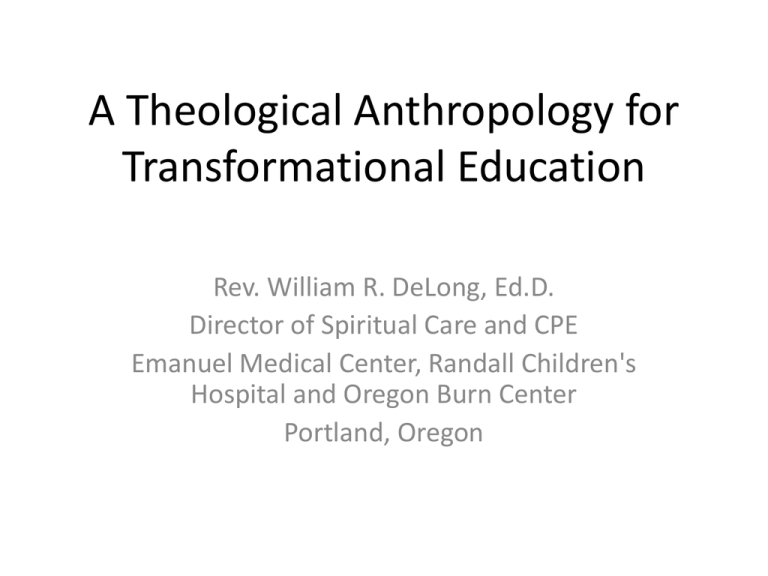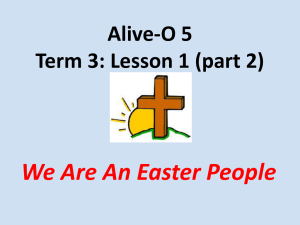A Theological Anthropology for Transformationl
advertisement

A Theological Anthropology for Transformational Education Rev. William R. DeLong, Ed.D. Director of Spiritual Care and CPE Emanuel Medical Center, Randall Children's Hospital and Oregon Burn Center Portland, Oregon “Supervision is more than teaching and less than treatment.” -A.J. Solnit “Learning from Psychoanalytic Supervision” A Supervisory Belief • When the student’s anxiety gets coupled with the student’s curiosity, learning takes place. Definition of Supervision • “An educational method by which a supervisor, through a face-to-face relationship, enables students to learn about self, others, the spiritual , and ministry from clinical experience and examination of that experience so that students integrate their learning in their professional identity and functioning.” -- ACPE Definition of Terms (pg. 13). Supervisory Theory • Supervisory theory is a set of principles and beliefs that inform the educational process of supervision. • Supervisory theory informs the supervisory activity with clear and specific reasons for particular actions in the supervisory process. • These beliefs and principles come from theology, human personality development theory, and adult educational theory. However • Your theology, your adult education theory, and your personality theory will not tell you what to do and when to do it, that comes from a supervisory theory. • What to do and when comes from a supervisory theory. Theological Anthropology • A theological anthropology is designed to answer many of questions that arise in both the paper writing process and in supervisory theory, and will be expected to be addressed in the certification process. • A theological anthropology will provide theory to “behold” the human other, make assessments, and integrate theology, personality development, and how humans learn, and explain interventions. James Loder’s Convicted Knowing • Loder was the professor of educational philosophy at Princeton Seminary. • He outlines a four fold knowing event in his book The Transforming Moment. • I appropriated his work into a perspective for supervision and is largely outlined in chapter four of my book Courageous Conversations: The Teaching and Learning of Pastoral Supervision. The Four Fold Knowing Event • Loder describes the human condition in four specific and identifiable aspects: – Embodiment – The Self – The Void – The Holy Meaning Making through Embodiment • Humans first begin to “know” through our bodies. • Our bodies limit us in time and space, includes our neuro-pathways, experiences of pain, hunger, and more. • The human experience begins with “body,” we move and breathe and have our being initially in and through body. • As body, we experience the finitude of human being. • This is most notably experienced through age, sickness, and ultimately death itself. Second body • Carolyn Gratton speaks of our second body which includes our experience of gender, sexual orientation, and culture. • Through the initial experience of body we develop significant perspectives of how we make meaning in the world. • Through continual exchange of body, culture, gender we learn our first way of knowing. Meaning Making as Self • But, human being is not simply about body. • The second way of knowing is through the sense of self. This includes a sense of myself, a unique “I” who inhabits this body. • “Men [people] differ not just because they select different objects or facts from the common world, but because they see different worlds; their perspectives have been formed by highly individual experiences.” -Loder Meaning Making as Self • The self is that part of humans that brings meaning from the phenomena of life. • The second dimension transcends the embodiment and continually recomposes the world. The self is the knower of the embodied world and yet stands outside it. • The self contains all that we would call psychology and personality. • And it is the self that is in relationship with other selves and with itself as self reflection. Meaning making and the Void • The existential reality of non-being is the third dimension of knowing– the void. • The void breaks into our experience of body and self. • Called by many names and known through many experiences, several metaphors elucidate the void “non-being, death, loneliness, emptiness, shame, and the demonic.” All of these threaten our understanding of self. The Void continued • The void breaks into our lived experience in unexpected ways and disrupts the continuity of the “world” we have created. • The void is experienced in trauma, premature death, sickness, and violence, job loss or divorce. • In all these instances the threat of non-being again breaks into our reality. And with it the threat of destruction and loss. • The power of this third dimension of human existence leads most of us to construct “worlds” within which the void has no part. The Void continued • “When encountering the void, the temptation of the self is to cling to a false world where the void has no meaning. In so doing, the self creates and perpetuates a world where it is deceived and is the deceiver. • This process separates the self from its source of true identity, The Source of All Being or the Holy. • When the self is presented with the awesomeness of the void, it may ground itself in some other form of power which ultimately cannot sustain it. Thereby creating a false ground of identity. The Void continued • To live in the presence of the void is to be filled with the awful reality of non-being and separation from the Holy. • Living in separation from the Holy is unbearable for humans. Thus the attempt to create a world where the void is not present creates pain, isolation, emptiness and more. • The void—breaking into our lived world of human being. . . Brings with it a process which is transformational, a process that leads to the Holy. Meaning Making and the Holy • To wrestle honestly with the void will always bring about the reality of transformation, the Holy. • The Holy is the source of all being and is the fourth dimension of human knowing. • The self seeks to ground itself in the Holy as it is the source of its truest identity. The Holy Continued • “We continue to live precisely because in the center of the self, for all of its potential perversity, we experience again and again the reversal of those influences that invite despair and drive toward void. Kierkegaard repeatedly insisted with bewildering brilliance that the faces of the void become the faces of God.”James Loder The Holy Continued • The reversal of the dynamics of the void are experienced as grace, love, acceptance, justice and more. • The Holy transforms the dimension and experience of the void and meaninglessness. • Thus, as much as the void lifts up our alienation, at the same time it speaks the words of transformation. The Holy Continued • The art of spiritual care invites a person to look at the truth of the void, grounded and surrounded in a relationship of trust and confidence that moves toward the transformation of the void by engagement and acceptance of the Holy. • In this way, the self and the body are secured in the ground of all being, the Holy which enables the self to live in a world where the void is real and active, but not ultimate. Four Dimensions of Human Being Embodiment: Culture, Gender, Body, Sexuality. Self: Psychological world, logical constructions, moral actions, agency VOID: Death, grief, loneliness, shame, isolation, despair. Holy: grace, love, transformation, acceptance Embodiment Self Patient Healing Void Student Transformational Learning Supervisory Inquiry Holy Chaplain Patient Inquiry Resistance in Learning • As you move with a student from the outer ring of body to the inner ring of the Holy, the student’s resistance to the process will increase. • As the chaplain moves from body (what brought you to the hospital) to the Holy, the patient’s resistance will increase. Applying Loder’s Anthropology to Mezirow’s Transformational Learning Meaning Perspectives • The anthropology just outlined leads an individual to have what Mezirow calls “meaning perspectives.” • Meaning perspectives are the unconscious assumptions and beliefs about the worlds formed by a unique experience of meaning making. Mezirow says they create the “lions at the gates of awareness.” Meaning Perspectives • Meaning perspectives are designed to provide the individual with ways of knowing that help them to have mastery or competence in the world. • They are formed by “worlds” created by the person as they move from body to self to void and the Holy. • Some are helpful, some are not. They often remain unexamined, until they engage in experiential learning such as CPE. Examples of common meaning perspectives • Better to remain silent than to risk being critiqued. • Authority figures are only out to condemn you and exercise power. • Suffering is to be ignored and focus only on the positive. • I can only learn from an expert and not from peers. • My competence depends upon your incompetence. Meaning Perspectives • “as adult learners, we are caught in our own histories. However good we are at making sense of our experiences, we all have to start with what we have been given and operate within horizons set by ways of seeing and understanding that we have acquired through prior learning.” – Jack Mezirow Embodiment Self Patient Healing Void Student Transformational Learning Supervisory Inquiry Holy Chaplain Patient Inquiry Mezirow’s Phases of Learning 1. 2. 3. 4. 5. 6. 7. 8. Interpretation Scanning Propositional Construal Reflection Imaginative Insight Reinterpretation Remembering Action Interpretation • A conflict occurs in a concrete experience which does not fit into the pre-existing meaning perspective. • This may stem from a cognitive assessment or arise as an uncomfortable or unexpected feeling. • Increased anxiety usually follows. • This discomfort can become quite pronounced. Scanning • Given the mismatch between the meaning perspective and the reality of the situation, an attempt is made to find solutions to the problem. At this stage, the problem solving usually remains within the original expectation. • Scanning eventually leads to a questioning of the meaning perspective that is no longer accurate. • Again, this can be accompanied by significant anxiety, stress and personal pain. Propositional Construal • Formulating a representation of the experience based upon beliefs (meaning perspectives), feelings, thoughts and observations. • A verbatim session can be seen as a student’s attempt to form the problem into a representation that can be worked with. • This is an attempt to present the “problem.” Resistance will lead the student to present a representation that is not truly at the issue (an attempt to stay with the original meaning perspective, usually unconscious. Reflection • At this stage the learner seeks to examine the quality of the solution presented. • Students begin with observations and facts, “The reason the visit did not go well was because I stood too far from the patient when I introduced myself.” • Reflection moves from the level of facts to the level of meaning, “I was anxious so I left the minute the family said we should pray.” • The goal is to help the student increasingly focus upon the meaning perspective that was operating for him or her. Imaginative Insight • When anxiety or repeated perceived failures continue, the student moves to make a new stab at the solution. • This often occurs with great energy and has the ah-ha quality to it. Often this is a combination of many previous attempts of propositional construal. • It is accompanied by increased self confidence and trust in the process and the supervisor. Lowered anxiety is also seen and greater sense of competence. Reinterpretation • The student now begins a process of integrating the new awareness or meaning perspective with already existing perspectives. • This can act in a domino effect where integrating one perspective begins to cause a questioning of another. . . And the process begins again with that new interpretation. Remembering • Remembering occurs when the student is confronted with a similar clinical situation and remembers the new awareness or new meaning perspective. Action • Action phase is when the student begins to consistently operate with the new meaning perspective that has been acquired. Transformational Learning • The phases just outlined occur over and over again with a student. • I cannot understate that students feel like these learning perspectives are a part of themselves and it often feels like they are giving up on their own sense of self. • The phases require consistent empathic attunement with the student and her or his learning process. A brief Overview of an Intersubjective Approach to supervision • • • • Empathic Attunement Missed Attunement Acknowledged Limits to Knowledge Parallel Process The Importance of Attunement • Attunement is seeking to understand the meaning perspective of the student “from within their subjective perspective.” Heinz Kohut called this empathy in self psychology. • Attunement to the subjective inner world of the student is critical to the intersubjective process. • My own sense is that an inter-subjective psychological approach is most helpful with this anthropology and learning theory. Missed attunement • Misattunement is perhaps the most important aspect of this theoretical approach. In intersubjective theory: – Supervisor owns the moments of mis-attunement and explores this with the student. This is not countertransference! – Supervisor acknowledges his or her own central organizing principle (meaning perspective) and how it is being activated with the student in the moment. Acknowledged Limits to Knowledge • “We do not believe that the analyst (Supervisor) possess any “objective” knowledge of the patient’s (student’s) life or of human development and human psychological functioning. What the Supervisor possess is a subjective frame of reference of his/her own, deriving from a multiplicity of sources and formative experiences, through which he or she attempts to organize the analytic data into a set of coherent themes and interrelationships. The supervisor’s frame of reference must not be elevated to the status of objective fact. Indeed, it is essential that supervisors continually strive to expand their reflective awareness of their own unconscious organizing principles, including especially those enshrined in their “objective knowledge and theories”, so that the impact of these principles on the supervisory process can be recognized and itself become a focus of the supervisory process.” What from our intersubjective perspective, constitutes the essence of a supervisory alliance? It is surely not the bond formed by the student’s commitment to follow the insights of the supervisor. In our view the foundations of a supervisory alliance are established by the supervisor’s commitment to seek consistently to comprehend the meaning of the student’s expressions, his or her affect states, and, most centrally, the impact of the supervisor from a perspective within rather than outside the stance of “sustained empathic inquiry.” -Stolorow, Brandchaft, and Atwood Parallel Process • What happens in the clinic happens in the supervisory session. • What happens in the supervisory session happens in the clinic. • Can be conscious or unconscious. Interlocking Area of Supervisory Attention • Attention is required in each relationship Training Supervisor/ Supervisor Supervisor/Student Student Chaplain/ Patient Questions? Comments, Observations, Gasps of Pain, disbelief, or panic?








